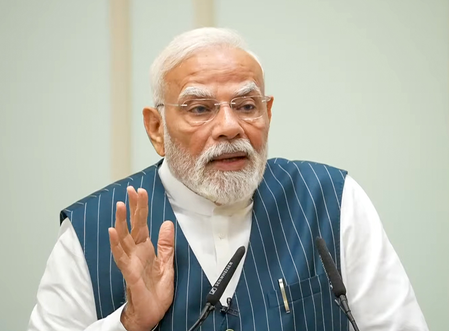
The has tiptoed down from its lofty peaks, not with panic, but with the kind of deliberate step back that happens when the house lights dim before the curtain rises. Traders aren’t running for the exits—they’re simply making sure their chips are stacked neatly ahead of what could be the most choreographed central bank performance of the year.
A two-day Fed meeting is underway, and the odds of a 25bp cut aren’t just priced—they’re tattooed into futures curves with a 100% certainty. The real suspense lies not in the move itself, but in the tone Powell delivers when he steps up to the mic.
This is why the tape feels like a “sell-the-news” setup. Rate cuts are no longer a surprise; they’re part of the expected script. To shift the plot, the Fed would have to go off-book—either with a shock 50bp cut, or by wrapping a 25bp trim in language so hawkish or dovish it bends the narrative arc.
But that’s also why equity markets are near record levels, why volatility markets are mostly unoccupied, and why desks everywhere are positioned for fortune rather than tragedy, as traders essentially anticipate the Fed to follow the markets’ preferred script.
Meanwhile, the is caught in its own storm. “ ” has become the quiet mantra across FX desks, as the greenback drifts lower on the benign cocktail of easier Fed policy, resilient global equity sentiment, and whispers of détente between Washington and Beijing.
Trump and Xi are expected to talk by week’s end, with TikTok already a framework test case. Traders see a deal here not because TikTok itself is a macro lever, but because it signals that tariffs and reciprocal trade fire may be nudged off center stage.
Layer in the politics—Trump’s man Stephen Miran joining the Fed board—and the choreography looks less like monetary fine-tuning and more like a Mar-a-Lago revival of Abenomics. Miran has been outspoken about US dollar “overvaluation,” blaming it for everything from hollowed-out manufacturing to distorted wealth distribution.
It only takes one true believer at the Fed table to shift the debate, and markets know it. If history rhymes, a secular US dollar bear market may already be sneaking in through the back door, just as Japan’s yen collapse was sparked by policy fused with politics. When it rains in this FX cycle, it pours unwanted US dollars.
For their part, central banks themselves are undermining the US dollar by diversifying into , draining Treasuries, and quietly acknowledging that the U.S. is no longer at the top of their shopping list.
If the US dollar does enter a secular slide, emerging markets—left for dead for a decade—suddenly get a second act. Carry trades in and are already proving the point, while a firmer yuan fix could accelerate the whole EM complex higher.
Equities, for their part, are still climbing the wall of worry. Consumer spending refuses to buckle, are firm, and corporate earnings forecasts continue to grind higher. Bears forever point to stretched multiples, but even stripped of tech, the S&P is carrying itself on more than just AI fairy dust. AI remains the lodestar, but the broader market has its own momentum. Add in a Fed cutting into a non-recessionary environment, and history suggests risk assets can thrive.
Of course, turbulence always lurks in the wings. September and October are seasoned with volatility, trend-followers are stretched, and valuation skeptics are sharpening their knives. But retail dip-buyers are forever waiting in the aisles.
The real risk is inflation’s ghost. A series of cuts into sticky prices could eventually lift long rates, not sink them, as markets discover the Fed’s easing isn’t without cost. But for now, the spotlight stays on the short end, where validation of already-priced cuts is all that matters.
So tomorrow, Powell walks onstage with markets already holding their applause. A 25bp cut is the baseline, the choreography rehearsed. But whether the crowd leaves humming bullish melodies or muttering about politics dressed as policy will depend on the words, not the deed. In this theatre, the script is predictable—the improvisation is what traders will trade.
Trader View: US Dollar’s Blood on the Floor
The New York tape had that smell every trader knows—risk getting squared, books being flattened, P&L pulled off the table. The screens told the story: equities bled out at the open, tried a dead-cat bounce, and still limped into the bell red. No panic, just the mechanical de-risking that screams “Fed tomorrow.” nearly dragged itself green for a tenth straight day, but even the algos ran out of fuel. The generals—the Mag7—still walked tall while the rest of the infantry got shot to pieces. Classic positioning divergence.
Flow desks saw it: vol buyers came in heavy. Skew went bid, wings were paid up. The market’s bracing for a punch, but no one’s expecting a prolonged brawl—just a two-day burst of fireworks before the smoke clears.
Macro backdrop? Messy as a trader’s blotter after a bad . Hard prints—retail sales, IP—still showing muscle. Soft prints—NY Fed services, housing sentiment—rolling over. Traders are stuck in split-screen purgatory: is the economy still running hot or already cracking at the edges? That divergence killed the 50bps fantasy, pushed October odds lower, and shoved the real easing story out into 2026.
But the absolute carnage was in FX. The US dollar finally puked— , hitting its lowest close since early ’22. You could see it in the price action: bids evaporating, stops tripping all the way down. Gold took the baton, exploding through $3,700 for the first time in history—every macro fund on the Street will be high-fiving that print.
followed, lifted by the FX flows and the ever-toxic cocktail of Russian supply squeeze and Middle East flare-ups. made another run at $117k, but it’s a tired rally—ran into a wall of offers and stalled. looked worse, the spread topping out like a blown-up carry trade.
Rates were quieter but spoke volumes—Treasuries bid a touch, 5s leading. Nothing dramatic, just that subtle lean that says real money is hiding in duration before Powell takes the mic. But the street chatter is loud: if the Fed pushes back against this Goldilocks fantasy, those frothy corners of the tape—the junk tech, the levered beta, the meme-lite trash—get torched.
And that’s the razor Powell walks tomorrow. The dots may only budge a hair, two at most, but the presser is where the fireworks hit. He’s got to talk dovish enough to keep October alive without letting markets run riot. Miran’s entry could tilt the dots, Cook could dissent to make a point—any of it is headline risk that’ll rip through positioning.
Right now, the dollar’s bleeding, gold’s flexing, vol’s coiled, and traders are pacing. The floor feels like a high-risk Fed eve: nervous, twitchy, half the book flat, the other half leaning into tail risk. Everyone’s waiting for the bell, and no one wants to be the last person holding the last hot potato when Powell steps into the ring.



